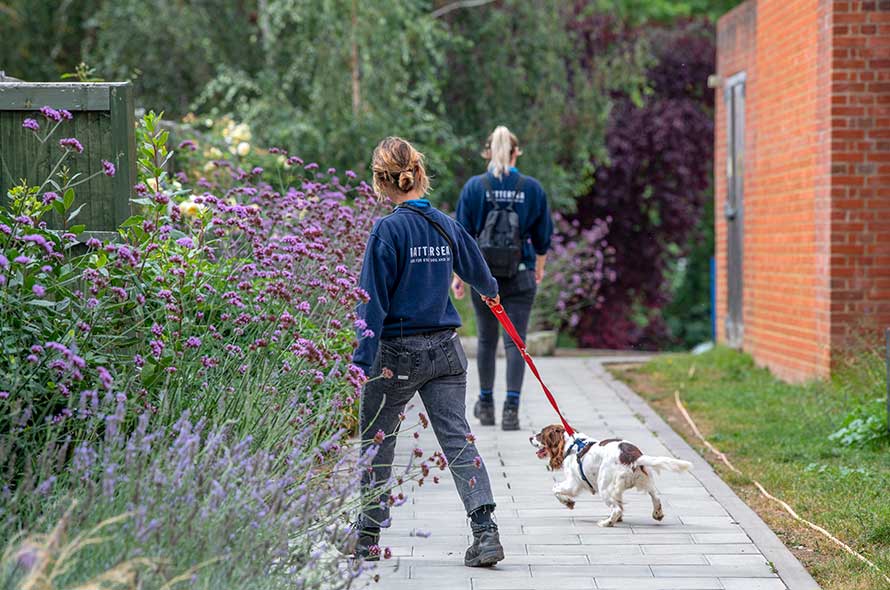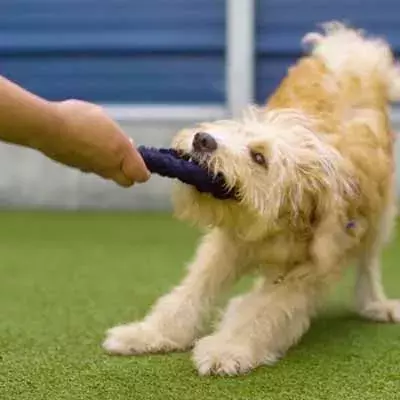Battersea’s volunteers and staff work hard across our three centres to make every dog’s stay with us as enriching as possible, and this includes creating dog-friendly sensory gardens.
Plain patches of grass aren’t the most exciting places for dogs, they benefit greatly from enriching and stimulating natural environments, just like we do.
A bit of dog-friendly landscaping can help decrease boredom and encourage natural behaviours, so here are a few simple things you can do to set off their senses.
GETTING STARTED
The first thing you need to do is check your boundaries. Make sure that all the fencing surrounding your garden is intact and secure. Check where foxes could have dug underneath a fence where your dog could slip out.
As you’ll be encouraging your dog to spend more time outside interacting with nature, you will also want to check that your garden doesn’t already contain any plants which are harmful to dogs.

CALMING WITH LAVENDAR AND ROSEMARY
Rosemary and lavender are two potent plants that your dog will love to sniff, and their aromas will leave them feeling zen. Their woody, robust structure makes them hard-wearing so perfect for any dog that likes to zoom around in your garden.
On top of that, they grow all year round in poor soil and survive well in a draught. You will also enjoy their scent and all the beautiful insects they will bring to your garden.
ENERGISING WITH MINT AND LEMON BALM
When your dog is in need of a little pick-me-up, they’ll enjoy sniffing and chewing on mint or lemon balm. In moderation, these are both said to aid your dog’s digestion too! They will enjoy the herbs more when planted in clumps, so avoiding mixing as you could send your dog into a sensory overload!
Easy to grow, these plants will die back in winter but they are invasive so you may want to plant them in a sunken plant pot to keep them under control. There is one species of mint, English pennyroyal (Mentha pulegium) which is known to be toxic to dogs, so avoid this.
NATURAL AGILITY
If you have an active dog that likes to jump and climb, then natural agility may be right up their street. Wooden stumps can be perfect for this, and your dog may also enjoy the nice woody aroma.
You can often source wood for free from a Tree Surgeon, so it doesn’t have to cost you anything. Ensure that the tree species is safe for dogs and free from disease before you bring it into your garden.
WHEATGRASS
Wheatgrass is super simple to grow and packed full of nutrients. It’s been shown to help with dog digestion and help boost energy levels. Lots of dogs can’t help but have a munch when they find it!
It can be grown in seed trays during the winter and then planted in the ground in the summer, and it loves a nice bright spot in the garden.
PANSIES
Dogs can’t see the same spectrum of colours like us, but they are able to see blues and yellows. Pansies commonly come in these colours, are safe for dogs and grown all year round, so planting them can provide a bit of visual stimulation.
Remember, pansies are rather delicate, so be prepared for your dog to potentially destroy them!
SAND PIT
Lots of dogs love to dig, so a sand pit can be a great solution and may discourage them from digging up your actual garden. If you decide to make your own doggie sand pit there are a few things to remember: Use soft, children’s play sand and avoid sharp builders’ sand, a weed supressing membrane will keep unwanted growth at bay and the pit will need proper drainage.
You will also want to bear in mind that your dog may use the sand pit as a toilet too, so make sure it is for your dog only and cleaned regularly.
Battersea and RHS share 5 top tips for creating the ultimate dog-friendly garden
Battersea and The Royal Horticultural Society (RHS) joined forces to share their five top tips to create the perfect garden for you and your dog. Battersea’s Lead Horticulturalist Dawn Grehan and RHS chief horticulturalist Guy Barter dig into gardening ideas to get your dog’s tail wagging
Incorporate areas to engage your dog’s senses
A sensory area of the garden is an ideal way to stimulate dogs’ senses while helping to keep them mentally stimulated and decrease boredom. Dogs love to explore by using their noses and there are many dog-friendly herbaceous plants and shrubs that can be planted for them to investigate such as rosemary, basil, thyme and lemon balm.
To keep dogs busy while tending to the garden, owners can set up brain games by hiding some of their pet’s favourite treats or toys around these plants. Offering different surfaces to stimulate dogs’ paws can also engage senses, such as grass, play-grade bark chip and garden paving for pets to follow their owners around the garden.
Make use of robust plants that can withstand playtime
Dogs love to run around and play in the garden, so it’s a good idea to have a range of plants that can endure a dog's day-to-day use and bursts of energy. Robust plants such as sedges, shorter grasses to run through, catmint and lavender are all good options.
Make your garden pleasing to your dog’s eye, too
As humans, we enjoy having a beautiful garden with plenty of things to look at, and you can also make it pleasing to the eyes of your pets by offering them some visual stimulation in their outdoor sanctuary. Dogs mainly see in blue and yellow, so to help them enjoy the garden just as much as us humans, you can look to plant yellow and blue dog-friendly plants such as cornflowers, pansies, asters and sunflowers. Pansies also grow all year round, allowing for a permanent feature in the garden for owners and their pets to enjoy.
Incorporate plenty of shaded areas for warmer months
As the weather gets warmer, it’s important to offer your pet plenty of shaded areas to keep cool and relax. You can make use of larger trees which are dog-friendly such as field maple and hawthorns, or larger shrubs such as camellias and deutzias, which will add a beautiful pop of colour to your outdoor space. When spending time in the garden with your dog in hotter weather, be sure to offer them plenty of water stations to keep hydrated.
Fence off anything that could be toxic to dogs
There are a number of plants that can be toxic to dogs which owners should be mindful of, such as alliums including onions, garlic and leeks, foxgloves and azaleas. If you have any plants in your garden that are toxic to dogs, ensure to enclose these off with a secure fence that your dog cannot get through, under or over.
All toxic plants can present different symptoms in dogs, from an upset tummy to vomiting and even heart problems. Any plant can cause side-effects when ingested and some animals may be more sensitive to plants that are commonly considered safe. Be sure to be vigilant when your pet is out in nature and if you are at all worried about your pet’s health, consult your vet immediately. More information on toxic plants to dogs can be found on the HTA website.
Get in touch on our social channels and let us know how you’re getting on with your dog sensory garden!



